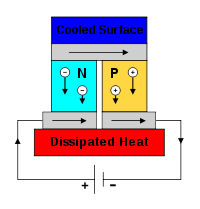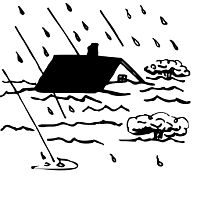
Thermoelectric Cooler
Over the past few years, I have managed to wear out three conventional dehumidifiers. By conventional, I merely refer to their used of heat pumps employing the vaporisation and condensation of a circulating fluid.
I’m not complaining (much) as they all had a pretty hard time, dealing with various leaking roofs and permanently damp areas around my house.
Notably, they all died for much the same reason, having lost gas over the years, none of them could be easily recharged as none of them were fitted with valves to allow the refrigerant to be topped up. These units are factory charged, and the ports are brazed to seal them forever once the job is done.
If I had a gripe, it would be about the quality of manufacture, which deteriorated markedly with each replacement, as each newer item (all similarly specified) lasted only about half as long as its predecessor, before the fans (bearings – “sealed for life”) started to play up, and the chillers chilled less and less as time passed.
With the rising cost of electricity, and these things running almost constantly and drawing around 300 W, when the last one gave up, I decided not to replace it.
However, I did still have one damp problem that was not easily fixed or prevented, and remains a nuisance.
Peltier effect
In plain English, a Peltier junction is a semiconductor that get hot on one side and cold on the other when voltage is applied and current flows through it. So, it acts as a heat pump, or a thermoelectric cooler, moving heat (energy) from one side to the other. There’s no motors, pumps, fluid, oils, or gases involved, so it’s quite efficient. Missing all the hardware – apart from a fan to move air over the junction – it’s also a lot quieter than compressor units.
They’ve been around for a while in the domestic market, and I have a handy cool box (portable battery operated fridge) that used the same device, and it works really well. My only grip is having to keep it running all the time, as the insulation used around the box is rubbish to say the least, and if not powered, it heat up to ambient a lot quicker than a conventional cool box.
Peltier dehumidifier

Still with a condensation problem to address, and not wanting to part with yet another £200 or so for an ordinary dehum(idifier) (which I reckoned would die even faster than its cousins), our local emporium had some ‘new’ Peltier dehums on offer for £50, so I thought it worth a try.
Drawing only 60 W and claiming only 600 ml collection per day (conventional claimed 300 W and 5 litres per day) the numbers seemed reasonable.
Sad to say, the reality has not been anywhere close.
In fact, having run the new dehum under various ambient temperatures and humidity levels, it barely manages to fill its little 600 ml tank in a week, let alone a day.
Having pulled it apart, the design just seems to lack efficiency.
The compressor types have a real heat exchanger matrices with large areas and close coupling to the chiller.
The Peltier has no such matrix, with only a solid aluminium heatsink with a few heavy fins which the air is channelled through.
At a guess, if the areas of the exchanger could be increased, and was better coupled to the junction, the more air could be treated, and more moisture could be condensed, extracted. As it is, the transit time of the air passing over the chiller is just too short for effective condensation to take place, and the air leave the dehum much as was when it arrived.
More, and thinner, fins are needed as far as I can see.
If only I had the tools to make something to try this.
How bad?

I had an example of just how poor this dehum works this week, when the sudden heavy rain that arrived at the start of the week revealed a failure in my flat garage roof, and the water started coming in through one corner.
This soaked the floor, and takes 2-3 days to dry itself out if I leave it.
I sat the Peltier dehum in the middle of the damp patch.
Yep… it was 3 days before the floor dried out, just the same as if there had been no dehum eating 60 W, and the dehum reservoir barely collected 100 ml in that time.
Somewhat short of claimed 600 ml per day, or even 100 ml per day. Remember, my compressor dehums did manage their claimed collection rate, when new.
Now for the fun fact of the day – I saw the same dehum for sale for £30 more than I paid in our local electronic specialists, but rated at 1,200 ml per day. I thought it might have had two junctions built-in (even though there is insufficient space), but when I got my hands on this “super” dehum and read the label, it was still just rated at 12 V and 5 A, and that’s still just 60 W. Same as mine, which barely makes 50 ml on a good day.
They do work, but just do it so incredibly slowly.
I can do better with a mop. bucket, sponge, and cloths!
CC cooler image by Ken Brazier via Wikimedia Commons.

Hi,
My niece bought me a P-E effect machine for a Christmas present as I live in a moblle (trailer) home – in 8 days it collected about 1.5 pints of water! maybe not great but now at least the floor feels dry enough to stand on. I’m limited on space so I store books and clothes under the bed – I’m going to keep the machine going for a while – it seems to need a rest after a couple of days to defrost the heatsink – lets see how it goes!
Hugh
LikeLike
Sounds about right, depending on the weather, mine sometimes suddenly collects a load, then virtually nothing.
In the cold/winter, it freezes into a block of ice, and has to be turned off. But little thaw, as the rooms are down about 5°C, so there is little latent heat to melt it, and it takes forever.
I’m hearing good things about the newer absorption dehumidifiers, and might buy one when finances are better.
Until then, I’m just using improved ventilation – better known as draughts!
LikeLike
Does anyone know the relationship between ambient temperature and moisture? If I heat the room up, will the machine collect more moisture or less? How much moisture is held in cold air as opposed to warm air? I wish my physics background were better but 50 years ago physics was not an important subject in our schools!
All the best.
LikeLike
I need the same answer as Hugh above… I bought a Peltier dehumidifier £39 with a 2L tank, but it has not collected more than half a cup over 10 days… the room is very cold (Scottish Highlands) the damp on the windows is ridiculous & the walls are starting to bubble… how can I increase the effectiveness of the machine? Is my room too cold? Thanks
LikeLiked by 1 person
Hi Lorna,
The real problem is the Dew Point, basically the temperature at which condensation begins to form on a surface.
Once your walls and windows get down to this temperature, then the moisture in the air will condense on those surfaces regardless of the presence of a dehumidifer. The only way to combat this effect is to raise the temperature of the surface ie heat the surfaces.
The little Peltier dehumidifier is no match for those with compressors, chillers, and fans, and collect little compared to their much more powerful and efficient cousins. The Peltier is not really all that very good value, and £100 to £150 on a proper dehum is better spent – but it also eats more electricity to drive it and its larger fan, but it extracts a lot more moisture. Peltiers also have a tiny exchange and collecting area compared to those with chillers.
Ventilation can help, as homes and rooms accumulate moisture from cooking, washing… and human breath!
Opening doors and windows where possible can help, while closing them traps this, and leads to damp and mould.
If you want an honest answer to “How can I increase the effectiveness of this machine?” then I am afraid that honest answer is “You can’t.”
They are primitive and inefficient, and unlike their big cousins, do not even have a cutout to stop them when the Peltier module has frozen into a block of ice. Proper dehums sense this, and switch off to defrost themselves before returning to operation,
LikeLike
Thanks so much for replying…. I have experienced the blocks of ice falling from this peltier dehum already, heard it dropping into the tank during the night.
I thought if I perhaps heated the room to at least 15-18 deg C it would help, but then again, more electricity is having to be used. I am trying to open the windows as often as the low & wet, often snowy temps will allow, but, hmm.. guess we have to wait 400 years for someone to invent something that DOES work…
Thanks again 🙂
LikeLike
What are the names of the dehums you purchased?
LikeLike
I plan to try one of these for the purpose of defogging the interior of a race car that has no air conditioning. With the car’s fan set on recirculate there’s not much volume inside and it’s really only collecting the moisture given off by the people in the car which is not much. One of the issues with some of the cheaper versions is that they don’t recirculate some of the air from the hot side back into the inlet to keep the condenser from frosting and clogging (which removes a large amount of the surface area available for operation).
LikeLike
Let me think for a moment…
No, moment not needed.
This will NOT work. Peltier can’t manage one person in a room, even with warm air bleed.
Make sure you buy it from someone that that offers a full money back no quibble service – you’ll need it.
There’s a reason pro-racers now use heated windscreens.
LikeLike
I’ve been using a Peltier-type 72W dehumidifier for a few years, but it’s only any use in a small space – like the inside of a car that’s parked up for the winter. Its effectiveness drops right off when the temp gets below 5degC. However, left to its own devices, it can remove a reasonable amount and has definitely contributed to keeping the inside mould-free.
Well, it did, until a really hard overnight freeze cracked the full container (I’d forgotten to empty it) and best of luck trying to get spares for any Brand-X makes.
I’d not bother with a Peltier type for any space larger than a car – perhaps a caravan, but a house or room is a waste of time and electricity with one of these – too puny.
LikeLike
Yup, you’ve nailed it on both counts: use in a small restricted space, fine for that, and… not for use in a place where it could freeze. They have none of the tricks built in that a proper dehum has as standard. Mine turned into a block of ice when the ambient temp got near zero (and I mean 5 degrees or so).
I’ve now got a new compressorless dehumidifier in the house, and it’s a gem. Seriously effective AND works all the way down to freezing, which the old compressor types simply could not get near, as their chillers freeze and ice up when the temperature approaches freezing.
LikeLiked by 1 person
The efficiency of a peltier element is around 4 times lower than normal compression systems or “heat pumps”. That efficiency is not maintained if the difference in temperature between the cold and hot side can not be maintained, therefore in most end user devices (poor design), only about 2 to 7% of the used energy is actually heat transfer, all the rest is just heat. I’ve used peltiers for various research projects, with power ranging from 100w to 1.2 kw, in single and multi junction, they all failed miserably, it’s just not efficient enough to be used in a open enviroment.
LikeLike
One thing I have noticed on many new models is that the bucket sizes seem smaller than older models. Also the 40, 50, 70 pint sizes do not refer to the water reservoir size, but the amount of water that the unit can pull out of the air per day. So a larger pint rating might mean you are emptying it more often.
how abthis website dehumidifierbuyerguide .com
LikeLike
Hi,
As a rule of thumb, cooling condensation atmospheric water generators do not work efficiently when the temperature falls below 18.3°C (65°F) or the relative humidity drops below 30%.
Winters in Scotland have an average low of around 0 °C (32 °F), with summer maximum temperatures averaging 15–17 °C (59–63 °F). This seams to be the reason for the very low efficiency you obtained with your device.
LikeLike
Yes.
Thanks. I think you just confirmed my original post.
But your temperatures for Scotland – are a joke. You need to find a better reference sources!
We’ve just had our summer, and the max was over 30°C in air, and over 40°C if measured on the ground.
And RH of less than 30% here? That’s almost hysterically funny, and not going to happen any season not called ‘summer’..
LikeLike
I’m in Sydney Australia. I bought a Philips DE5205 refrigeration type. In summer (30 to 40C) when its humid (say 80%) it fills a 3.7L tank every day. In cooler months, it takes 2 to 3 weeks to fill the tank. Getting tired of emptying the tank, but I’m loath to drill a hole in the floor for a permanent drain, because I know its going to fail one day. Been trying to find small refrigeration or Peltier types to put inside my small wardrobes, the big name (reputable) brands (even though they are all made in China) all seem to only have big whole of house units, and no small units. The Chinese Alibaba site has hundreds of small cheap units, but I’ve no idea which will work ok or not. Would prefer Peltier effect, if only I could be sure they worked !!
LikeLike
Pingback: The best dehumidifiers for most people in 2024 - HouseFresh